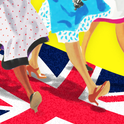Read more: I cannot wait to see what Ruth Davidson does next
The revival of the Scottish Conservatives has taken some observers by surprise. After Thursday's elections, they are the second largest party in Holyrood, 32 seats behind the governing Scottish National Party but seven ahead of Scottish Labour. What does it all mean?
One of the obvious takeaways is that the electoral system of proportional representation can keep a party from catastrophe. It rescued Labour this time, and has been saving the Scottish Tories since the first Holyrood elections in 1999. There is also a lesson in this about the longevity of parties: the Liberals are still around as the Liberal Democrats were recently in government for the first time since Lloyd George. Labour revived after the 1980s and the damage done by Bennism and the Militant tendency—and it will survive despite the damage Jeremy Corbyn is doing to it. Great political parties can take a lot of ruin.
The other conclusion to be drawn is that Scottish politics has found something new to articulate itself around: independence. With the voters split 55/45 over the issue in the 2014 referendum, both last year's general election and this year's parliamentary one show the nation is now split 50/50. The half leaning towards independence only have one party to turn to but the others have three and a half to choose among (the half being the Scottish Greens, whose support for secession does not form part of their core brand).
It is easy to cast this year's result solely as a disaster for Scottish Labour. It is a bitter blow indeed, but it derives from their inability to master the new binary choice in Scotland—are you for or against the union? Labour said “Both” and people punished that equivocation by voting SNP or Tory. Some detached observers would see a poetic justice in this electoral punishment. After all, Labour had spent the period from 1983-2010 asking the question: are you for or against the Tories? And did increasingly well over that period.
The apparent ease with which Labour dominated made Scotland appear a more radical country than it really is. Indeed, throughout much of its history Scots voted in huge numbers for the right-wing Unionist party. The Conservatives’ dominance here derived from the fact they were a Conservative and Unionist Party at a time when the union that mattered politically was the one between Northern Ireland and Great Britain. Or, to put it more bluntly, the Scottish Conservatives were a Protestant party in a country that was two thirds Protestant and one third Catholic. Sectarian divisions were never as fierce in Scotland as in Ulster but they were real—as any Celtic, Rangers, Hibs or Hearts fan can tell you.
Prosperity and secularisation hit the Scottish Tories hard. As working class Scots stopped going to church they started voting Labour. And a working class/middle class divide drove politics from the 60s onwards, making Scotland increasingly a Labour country. That eventually modulated into ABC (Anybody But the Conservatives) in the early 90s.
In all of this time Scottish politics has been, by and large, “small c conservative.” Homosexual activity was decriminalised in England and Wales in 1967—but it wasn’t until 1980 (when Thatcher was in power!) that it was in Scotland. This social conservatism was still there when a private referendum, organised by millionaire Brian Souter in 2000, massively backed keeping the homophobic Section 28 (Section 2A) in Scotland, which forbade local authorities from “promoting homosexuality.” When it was abolished by Donald Dewar in that year, a young Nicola Sturgeon was somewhat concerned about the change. (Of course, Section 28 wasn’t abolished in England until 2003—but we expect England to be more conservative than Scotland).
So, from Protestant/Catholic, working class/middle class, Tory/Not-Tory we have “progressed” to Pro/Anti-independence. All the while victory has gone not to radical parties but to centrists. Putting aside independence—which the voters have, for five years at least—the SNP are an SDP tribute act, a moderate party of the social market. The Scottish Tories have moved to the centre to claim their share of voters. The only questions for Scottish Labour are how long they take to move to the centre—and when can they conjure a new binary opposition from which they can again prosper.
Now read: Scottish democracy is in dreadful health
The revival of the Scottish Conservatives has taken some observers by surprise. After Thursday's elections, they are the second largest party in Holyrood, 32 seats behind the governing Scottish National Party but seven ahead of Scottish Labour. What does it all mean?
One of the obvious takeaways is that the electoral system of proportional representation can keep a party from catastrophe. It rescued Labour this time, and has been saving the Scottish Tories since the first Holyrood elections in 1999. There is also a lesson in this about the longevity of parties: the Liberals are still around as the Liberal Democrats were recently in government for the first time since Lloyd George. Labour revived after the 1980s and the damage done by Bennism and the Militant tendency—and it will survive despite the damage Jeremy Corbyn is doing to it. Great political parties can take a lot of ruin.
The other conclusion to be drawn is that Scottish politics has found something new to articulate itself around: independence. With the voters split 55/45 over the issue in the 2014 referendum, both last year's general election and this year's parliamentary one show the nation is now split 50/50. The half leaning towards independence only have one party to turn to but the others have three and a half to choose among (the half being the Scottish Greens, whose support for secession does not form part of their core brand).
It is easy to cast this year's result solely as a disaster for Scottish Labour. It is a bitter blow indeed, but it derives from their inability to master the new binary choice in Scotland—are you for or against the union? Labour said “Both” and people punished that equivocation by voting SNP or Tory. Some detached observers would see a poetic justice in this electoral punishment. After all, Labour had spent the period from 1983-2010 asking the question: are you for or against the Tories? And did increasingly well over that period.
The apparent ease with which Labour dominated made Scotland appear a more radical country than it really is. Indeed, throughout much of its history Scots voted in huge numbers for the right-wing Unionist party. The Conservatives’ dominance here derived from the fact they were a Conservative and Unionist Party at a time when the union that mattered politically was the one between Northern Ireland and Great Britain. Or, to put it more bluntly, the Scottish Conservatives were a Protestant party in a country that was two thirds Protestant and one third Catholic. Sectarian divisions were never as fierce in Scotland as in Ulster but they were real—as any Celtic, Rangers, Hibs or Hearts fan can tell you.
Prosperity and secularisation hit the Scottish Tories hard. As working class Scots stopped going to church they started voting Labour. And a working class/middle class divide drove politics from the 60s onwards, making Scotland increasingly a Labour country. That eventually modulated into ABC (Anybody But the Conservatives) in the early 90s.
In all of this time Scottish politics has been, by and large, “small c conservative.” Homosexual activity was decriminalised in England and Wales in 1967—but it wasn’t until 1980 (when Thatcher was in power!) that it was in Scotland. This social conservatism was still there when a private referendum, organised by millionaire Brian Souter in 2000, massively backed keeping the homophobic Section 28 (Section 2A) in Scotland, which forbade local authorities from “promoting homosexuality.” When it was abolished by Donald Dewar in that year, a young Nicola Sturgeon was somewhat concerned about the change. (Of course, Section 28 wasn’t abolished in England until 2003—but we expect England to be more conservative than Scotland).
So, from Protestant/Catholic, working class/middle class, Tory/Not-Tory we have “progressed” to Pro/Anti-independence. All the while victory has gone not to radical parties but to centrists. Putting aside independence—which the voters have, for five years at least—the SNP are an SDP tribute act, a moderate party of the social market. The Scottish Tories have moved to the centre to claim their share of voters. The only questions for Scottish Labour are how long they take to move to the centre—and when can they conjure a new binary opposition from which they can again prosper.
Now read: Scottish democracy is in dreadful health












